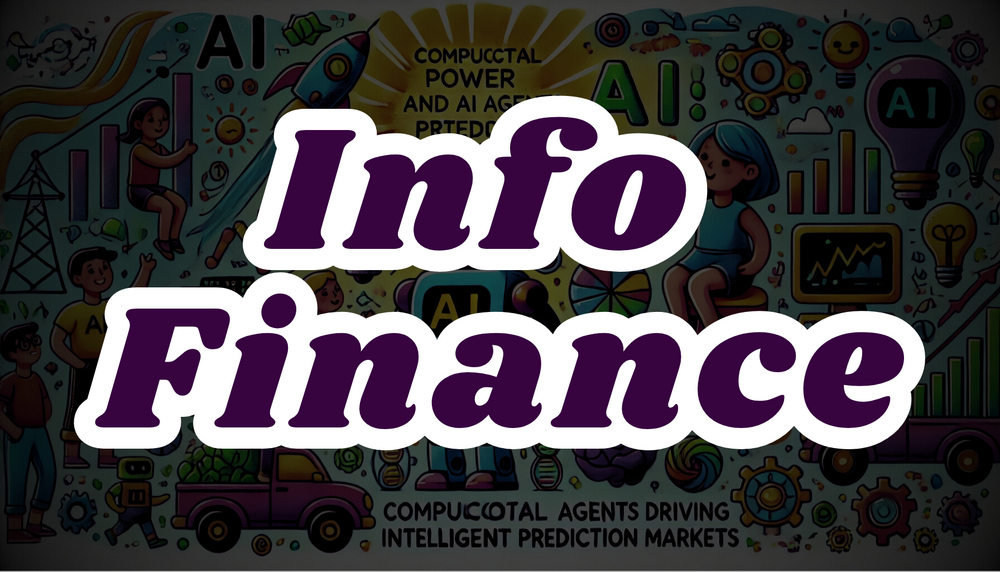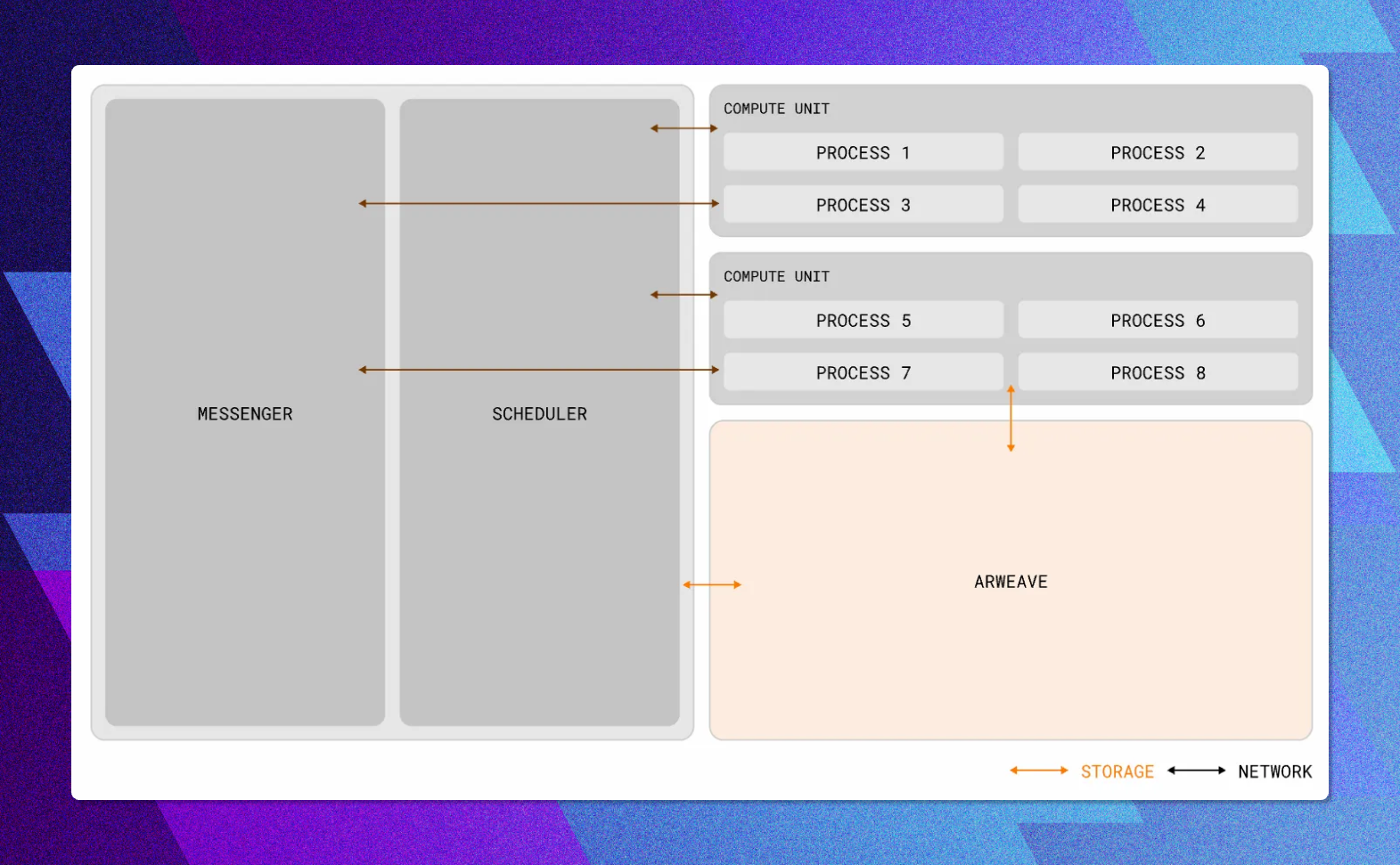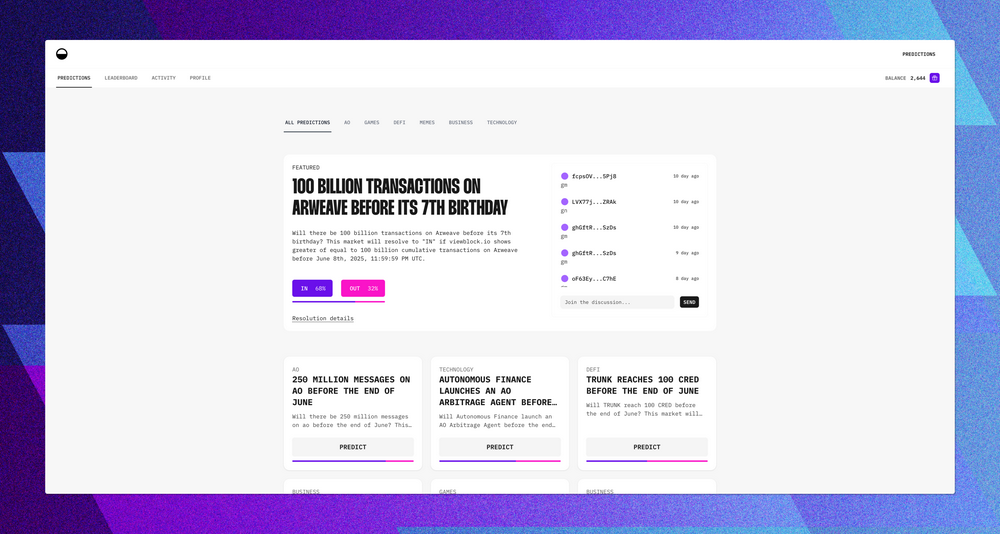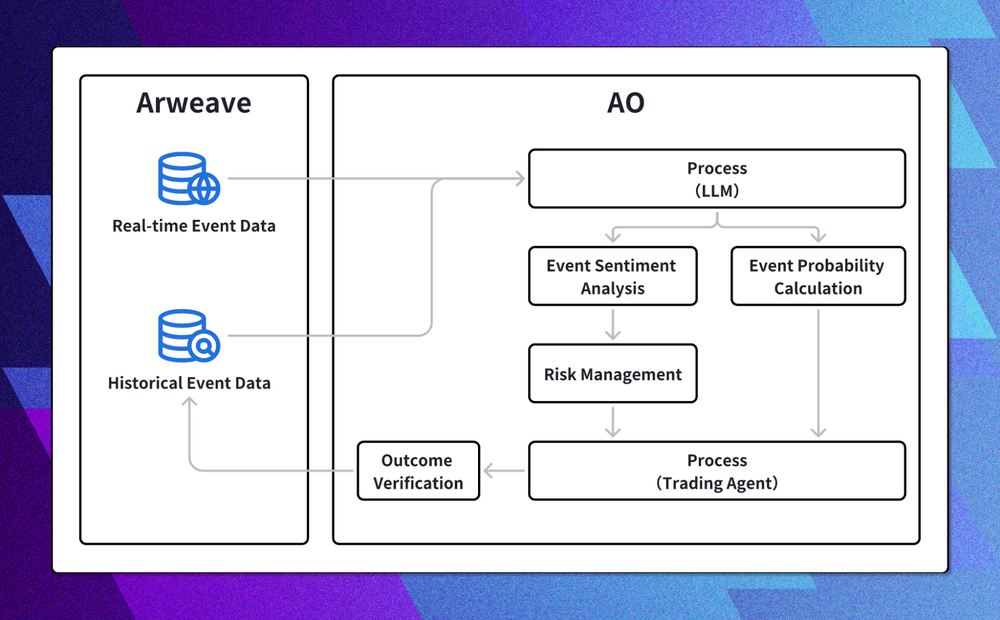
Author: Kyle
Reviewer: Sandy
Source: Content Association - Investment Research
Originally published on: PermaDAO
Original link: https://permadao.notion.site/2c3392ad748e4d45a7f94f1220afcda2?pvs=4
The ultimate prediction market, a press conference? In the just-concluded US election, Polymarket successfully predicted that Trump's chances of winning were higher than traditional polls with its market-driven data, which quickly attracted the attention of the public and the media. People gradually realized that Polymarket is not only a financial tool, but also a "balancer" in the information field, using the wisdom of the market to verify the authenticity of sensational news.
When Polymarket became a hot topic, Vitalik proposed a new concept - Info Finance. This tool that combines financial incentives and information can subvert social media, scientific research and governance models, and open up a new direction for improving decision-making efficiency. With the advancement of AI and blockchain, Info Finance is also moving towards a new turning point.
Facing the ambitious emerging field of information finance, are Web3’s technologies and concepts ready to embrace it? This article will take the prediction market as a starting point to explore the core concepts, technical support, and future possibilities of information finance.
Information finance: using financial tools to obtain and utilize information
The core of information finance is to use financial tools to obtain and utilize information to improve decision-making efficiency and accuracy. Prediction markets are a typical example. By linking problems to financial incentives, these markets incentivize accuracy and responsibility among participants and provide clear predictions for users seeking the truth.

As a sophisticated market design, information finance can guide participants to respond to specific facts or judgments, and its application scenarios also cover multiple fields such as decentralized governance and scientific review. At the same time, the emergence of AI will further lower the threshold, allowing micro-decision-making to operate effectively in the market, and promoting the popularization of information finance.
Vitalik specifically mentioned that the current decade is the best time to expand information finance. Scalable blockchain provides a secure, transparent and credible platform support for information finance, while the introduction of AI improves the efficiency of information acquisition and enables information finance to handle more sophisticated problems. Information finance not only breaks through the limitations of traditional prediction markets, but also demonstrates the ability to tap into the potential of multiple fields.
However, as information finance expands, its complexity and scale are increasing dramatically. The market needs to process massive amounts of data and make real-time decisions and transactions, which poses a severe challenge to efficient and secure computing capabilities. At the same time, the rapid development of AI technology has spawned more innovative models, exacerbating computing needs. In this context, a secure and feasible post-scarcity computing system has become an indispensable foundation for the sustainable development of information finance.
Today's situation, how to calculate the scarcity calculation system
There is currently no unified definition for "post-scarcity computing systems", but their core goal is to break through the limitations of traditional computing resources and achieve low-cost, widely available computing power. Through decentralization, resource enrichment, and efficient collaboration, such systems support large-scale, flexible execution of computing tasks, making computing resources close to "non-scarcity". In this architecture, computing power is freed from single-point dependence, and users can freely and inexpensively access and share resources, promoting the popularization and sustainable development of inclusive computing.
In the context of blockchain, the key features of post-scarcity computing systems include decentralization, abundant resources, low cost, and high scalability.
High-performance competition among public chains
Currently, major public chains are competing fiercely for performance to meet increasingly complex application needs. Looking at the current public chain ecosystem, the development trend is shifting from the traditional single-threaded mode to the multi-threaded parallel computing mode.
Traditional high-performance public chain:
- Solana: Since its design, Solana has adopted a parallel computing architecture to achieve high throughput and low latency. Its unique Proof of History (PoH) consensus mechanism enables it to process thousands of transactions per second.
- Polygon and BSC: Both are actively developing parallel EVM solutions to improve transaction processing capabilities. For example, Polygon introduced zkEVM to achieve more efficient transaction verification.
Emerging parallel public chains:
- Aptos, Sui, Sei, and Monad: These emerging public chains are designed for high performance by optimizing data storage efficiency or improving consensus algorithms. For example, Aptos uses Block-STM technology to achieve parallel transaction processing.
- Artela: Artela proposed the EVM++ concept, which enables high-performance customized applications in the WebAssembly runtime through native extensions (Aspect). With the help of parallel execution and elastic block space design, Artela effectively solves the EVM performance bottleneck and greatly improves throughput and scalability.
The performance competition is in full swing, and it is still difficult to determine which one is better. However, in this fierce competition, there are also alternative solutions represented by AO. AO is not an independent public chain, but a computing layer based on Arweave, which achieves parallel processing capabilities and scalability through a unique technical architecture. AO is definitely also a strong competitor in the development of post-scarcity computing systems, and is expected to help the large-scale implementation of information finance.
Carrying information finance, AO's blueprint for construction
AO is an Actor Oriented computer running on the Arweave network, providing a unified computing environment and an open messaging layer. Through a distributed and modular technical architecture, it provides the possibility for large-scale information finance applications and the integration of traditional computing environments.

AO's architecture is simple and efficient, and its core components include:
- Process is the basic computing unit in the AO network, and interaction is achieved through message transmission;
- Scheduling units (SUs) are responsible for ordering and storing messages;
- Computing units (CUs) are responsible for state calculations;
- Messenger units (MUs) are responsible for the delivery and broadcasting of messages.
The decoupling design between modules gives the AO system excellent scalability and flexibility, enabling it to adapt to application scenarios of different scales and complexities. Therefore, the AO system has the following core advantages:
- High throughput and low latency computing power : The parallel process design and efficient message passing mechanism of the AO platform enable it to support millions of transactions per second. This high throughput is essential to support a global information and financial network. At the same time, AO's low latency communication characteristics can ensure the immediacy of transactions and data updates, bringing users a smooth operating experience.
- Unlimited scalability and modular design : The AO platform adopts a modular architecture and achieves extremely high scalability by decoupling virtual machines, schedulers, messaging, and computing units. Whether it is the growth of data throughput or the access of new application scenarios, AO can adapt quickly. This scalability not only breaks through the performance bottleneck of traditional blockchains, but also provides developers with a flexible environment for building complex information financial applications.
- Support for large-scale computing and AI integration : The AO platform already supports the WebAssembly 64-bit architecture and can run most complete large language models (LLMs), such as Meta's Llama 3, providing a technical foundation for the deep integration of AI and Web3. AI will become an important driving force for information finance, involving applications such as smart contract optimization, market analysis, and risk prediction, and the large-scale computing capabilities of the AO platform enable it to efficiently support these needs. At the same time, through the WeaveDrive technology to access Arweave with unlimited storage, the AO platform provides unique advantages for training and deploying complex machine learning models.
AO has become an ideal carrier platform for information finance with its high throughput, low latency, unlimited scalability and AI integration capabilities. From real-time transactions to dynamic analysis, AO provides excellent support for the implementation of large-scale computing and complex financial models, paving the way for the popularization and innovation of information finance.
The Future of Information Finance: AI-Driven Prediction Markets
What should the next generation prediction market of information finance look like? Looking back, traditional prediction markets have long faced three major pain points: insufficient market integrity, high barriers to entry, and limited popularity. Even Web3 star projects such as PolyMarket have not been able to completely avoid these challenges. For example, the Ethereum ETF’s prediction event challenge period was too short or the UMA voting rights were too concentrated, which was questioned as a possible manipulation risk. In addition, its liquidity is concentrated in hot areas, and the participation in the long-tail market is low. In addition, the fact that users in some countries (the United Kingdom and the United States) are restricted by regulatory restrictions further hinders the popularity of prediction markets.
The future development of information finance needs to be led by a new generation of applications. AO's excellent performance conditions provide fertile ground for such innovations, among which prediction market platforms represented by Outcome are becoming a new focus of information finance experiments.

Outcome has already taken shape as a product, supporting basic voting and social functions. Its real potential lies in the future deep integration with AI, using AI agents to establish a trustless market settlement mechanism, and allowing users to independently create and use prediction agents. Only by providing the public with a transparent, efficient, and low-threshold prediction tool can it further promote the large-scale popularization of the prediction market.
Taking Outcome as an example, the prediction market built on AO can have the following core characteristics:
- Trustless Market Resolution : The core of Outcome lies in Autonomous Agents. These agents are driven by AI and operate independently based on preset rules and algorithms to ensure the transparency and fairness of the market resolution process. Since there is no human intervention, this mechanism minimizes the risk of manipulation and provides users with reliable prediction results.
- AI-based forecasting agents : The Outcome platform allows users to create and use AI-driven forecasting agents. These agents can integrate multiple AI models and rich data sources for accurate analysis and forecasting. Users can customize personalized forecasting agents according to their own needs and strategies, and participate in forecasting activities in various market themes. This flexibility significantly improves the efficiency and applicability of forecasts.
- Tokenized incentive mechanism : Outcome introduces an innovative economic model where users can receive token rewards by participating in market forecasts, subscribing to proxy services, and trading data sources. This mechanism not only enhances the user's motivation to participate, but also provides support for the healthy development of the platform ecosystem.
AI-driven prediction market workflow
Outcome introduces AI models to achieve semi-automatic or fully automatic agent mode design, which can provide innovative ideas for information finance applications widely built on Arweave and AO. It roughly follows the following workflow architecture:

1. Data Storage
- Real-time Event Data: The platform collects event-related information through real-time data sources (such as news, social media, oracles, etc.) and stores it in Arweave to ensure the transparency and immutability of the data.
- Historical Event Data: Saves past event data and market behavior records, provides data support for modeling, verification, and analysis, and forms a closed loop of sustainable optimization.
2. Data Processing and Analysis
- LLM (Large Language Model): LLM is the core module for data processing and intelligent analysis (that is, an AO process), responsible for in-depth processing of real-time event data and historical data stored in Arweave, extracting key information related to the event, and providing high-quality input for subsequent modules (such as sentiment analysis and probability calculation).
- Event Sentiment Analysis: Analyze the attitudes of users and the market towards events (positive/neutral/negative), providing a reference for probability calculation and risk management.
- Event Probability Calculation: Based on sentiment analysis results and historical data, it dynamically calculates the probability of an event to help market participants make decisions.
- Risk Management: Identify and control potential risks in the market, such as preventing market manipulation, abnormal betting behavior, etc., to ensure the healthy operation of the market.
3. Prediction Execution and Verification
- Trading Agent: The AI-driven trading agent is responsible for automatically executing predictions and bets based on analysis results without the need for manual user intervention.
- Outcome Verification: The system verifies the actual outcome of an event through mechanisms such as oracles, and stores the verification data in the Historical Event Data module, ensuring the transparency and credibility of the results. In addition, historical data can also provide a reference for subsequent predictions, thus forming a closed-loop system that is continuously optimized.
This workflow realizes efficient, transparent and trustless prediction agent application through AI-driven intelligent prediction and decentralized verification mechanism, lowers the threshold for user participation and optimizes market operation. Relying on AO's technical architecture, this model may lead information finance to intelligent and popular development and become the core prototype of the next generation of economic innovation.
Summarize
The future belongs to those who are good at extracting the truth from the chaos of information. Information finance is redefining the value and use of data with the wisdom of AI and the trust of blockchain. From AO's post-scarcity architecture to Outcome's intelligent agent, this combination makes the prediction market no longer just a calculation of probability, but a re-exploration of decision science. AI can not only lower the threshold for participation, but also make it possible to process and dynamically analyze massive data, opening up a new path for information finance.
As Alan Turing said, computing brings efficiency, while wisdom inspires possibilities. Dancing with AI, information finance is expected to make the complex world clearer and promote society to find a new balance between efficiency and trust.
Reference Materials














